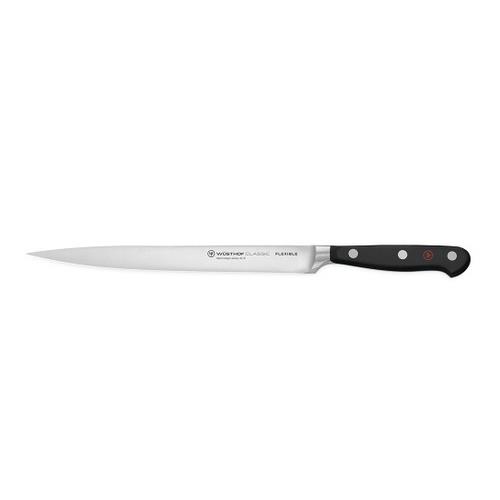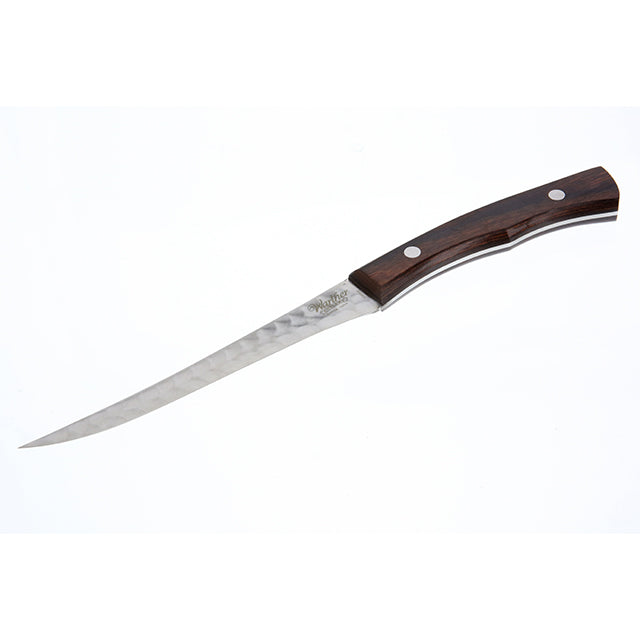Why every fishing enthusiast needs a fish knife
Discover the Necessary Attributes to Try To Find in a Top-Quality Fish Knife
When choosing a fish knife, several crucial features require focus. The blade material substantially influences toughness and sharpness, while flexibility plays an important role in precision. Additionally, the handle design impacts comfort throughout expanded use. Edge retention and safety attributes are likewise vital for useful usage. Understanding these components will guide consumers toward making an informed option, yet the subtleties of their relevance may not be right away clear.
Blade Product and Building And Construction
The performance of a fish knife mostly rests on its blade material and construction - fish knife. Premium fish knives commonly feature blades made from stainless steel, high-carbon steel, or a combination of both. Stainless steel is preferred for its corrosion resistance and reduced maintenance, making it perfect for freshwater and deep sea atmospheres. High-carbon steel, while prone to rusting, provides remarkable sharpness and side retention, appealing to those who prioritize cutting performance
The building and construction of the blade also plays a vital role in its efficiency. Full-tang blades, which prolong the whole size of the manage, supply enhanced stamina and equilibrium. In contrast, partial-tang blades may jeopardize sturdiness. Additionally, the density of the blade should be considered, as thinner blades permit a lot more accurate cuts, essential for fragile fish filleting. Inevitably, a well-constructed blade, making use of the ideal products, is basic for achieving the most effective outcomes when preparing fish.
Blade Versatility and Length
Blade adaptability and length are vital variables that considerably affect the efficiency of a fish knife. A flexible blade enables precise cuts and the capacity to navigate around bones and skin, making it vital for filleting fish efficiently. The ideal amount of versatility can improve control, enabling the customer to achieve tidy, smooth cuts with marginal initiative.
In regards to size, fish knives usually range from 6 to 9 inches. A longer blade is useful for larger fish, giving the reach required for efficient filleting. Conversely, a shorter blade uses ability to move, making it appropriate for smaller sized fish or elaborate jobs.
Ultimately, the selection of versatility and size need to align with the specific fishing needs and choices of the customer. A well-balanced combination of these characteristics guarantees optimum performance, boosting the total fish prep work experience.
Deal With Style and Comfort
When making use of a fish knife, a well-designed take care of is necessary for making sure convenience and control. The take care of need to fit firmly in the hand, allowing for a company hold throughout complex tasks such as filleting or skinning fish. Products like rubber, wood, or composite give different levels of comfort and traction, influencing the user's experience.
Ergonomic functions are also crucial; contours that follow the natural shape of the hand can decrease exhaustion throughout extended usage. Additionally, the manage's appearance plays a substantial duty in preventing slippage, particularly when collaborating with damp hands.
Weight circulation is an additional aspect that adds to the overall balance of the knife, enhancing ability to move. A comfy handle design not only boosts efficiency but also promotes security, as a safe grasp minimizes the danger of crashes (fish knife). Ultimately, a thoughtful manage style can considerably elevate the effectiveness of a fish knife in cooking applications
Side Retention and Developing
While making use of a fish knife, preserving a sharp edge is critical for attaining clean cuts and specific filleting. A quality fish knife should exhibit outstanding side retention, enabling it to stay sharp with numerous uses. This characteristic is frequently figured out by the kind of steel used in the blade; high-carbon stainless steel is frequently chosen because of its equilibrium of hardness and corrosion resistance.

Safety Functions and Sheath Options
When picking a fish knife, many safety and security functions and sheath options are crucial factors to consider. A safe and secure and ergonomic deal with reduces the danger of slips throughout use, improving customer security. Textured holds and finger guards additionally stop accidents, permitting better control while filleting fish.
Additionally, a blunt idea can decrease the danger of puncture injuries, making it a more secure choice for newbie individuals.
Sheath choices additionally play a vital role in security. A well-designed sheath safeguards the blade, protecting against unintentional cuts when the knife is kept or delivered. Sheaths made from long lasting products, such as nylon or tough plastic, deal included security versus ecological aspects.
Some sheaths feature belt clips or loops, making certain the knife is quickly available while staying secure. Inevitably, focusing on safety features and sheath alternatives contributes substantially to the click here general performance and customer experience of a fish knife.
Frequently Asked Inquiries
What Is the most effective Brand Name for Fish Knives?
The ideal brand for fish knives frequently differs by choice, however distinguished names like Wüsthof, Victorinox, and Shun are frequently advised for their workmanship, durability, and sharpness, making them top selections amongst culinary lovers and professionals alike.
Can Fish Knives Be Made Use Of for Various Other Kinds Of Fish?
Fish blades can without a doubt be utilized for various other sorts of fish. Their style and intensity make them flexible enough for numerous fish types, enhancing the total experience of filleting and preparing various kinds of seafood.

How Do I Clean and Maintain My Fish Knife?
To clean and preserve a fish knife, rinse it with warm water after use, delicately scrub with moderate soap, completely dry extensively, and store in a safety sheath to stop damage and rust. Regular honing is essential.
Are There Fish Blades Especially for Left-Handed Users?
Yes, there are fish blades made especially for left-handed individuals. These knives include reversed blade angles and ergonomic takes care of, guaranteeing convenience and effectiveness for left-handed individuals while filleting and preparing fish. Quality choices are offered from different manufacturers.
What Is the Cost Array for Top Quality Fish Knives?
Quality fish knives generally range from $20 to $150, depending upon materials, brand track record, and workmanship. Higher-end options may feature premium ergonomics and specialized styles, while economical selections still supply acceptable performance for informal users.
The performance of a fish knife mostly pivots on its blade material and building and construction. Top notch fish knives usually feature blades made from stainless steel, high-carbon steel, or a combination of both. Blade flexibility and size are vital aspects that greatly influence the efficiency of a fish knife. Fish knives can indeed be utilized for various other kinds of fish. These blades include reversed blade angles and ergonomic handles, making sure convenience and effectiveness for left-handed individuals while filleting and preparing fish.